A cell-penetrating peptide based on the interaction between c-Src and connexin43 reverses glioma stem cell phenotype
- PMID: 24457967
- PMCID: PMC4040690
- DOI: 10.1038/cddis.2013.560
A cell-penetrating peptide based on the interaction between c-Src and connexin43 reverses glioma stem cell phenotype
Abstract
Connexin43 (Cx43), the main gap junction channel-forming protein in astrocytes, is downregulated in malignant gliomas. These tumors are composed of a heterogeneous population of cells that include many with stem-cell-like properties, called glioma stem cells (GSCs), which are highly tumorigenic and lack Cx43 expression. Interestingly, restoring Cx43 reverses GSC phenotype and consequently reduces their tumorigenicity. In this study, we investigated the mechanism by which Cx43 exerts its antitumorigenic effects on GSCs. We have focused on the tyrosine kinase c-Src, which interacts with the intracellular carboxy tail of Cx43. We found that Cx43 regulates c-Src activity and proliferation in human GSCs expanded in adherent culture. Thus, restoring Cx43 in GSCs inhibited c-Src activity, which in turn promoted the downregulation of the inhibitor of differentiation Id1. Id1 sustains stem cell phenotype as it controls the expression of Sox2, responsible for stem cell self-renewal, and promotes cadherin switching, which has been associated to epithelial-mesenchymal transition. Our results show that both the ectopic expression of Cx43 and the inhibition of c-Src reduced Id1, Sox2 expression and promoted the switch from N- to E-cadherin, suggesting that Cx43, by inhibiting c-Src, downregulates Id1 with the subsequent changes in stem cell phenotype. On the basis of this mechanism, we found that a cell-penetrating peptide, containing the region of Cx43 that interacts with c-Src, mimics the effect of Cx43 on GSC phenotype, confirming the relevance of the interaction between Cx43 and c-Src in the regulation of the malignant phenotype and pinpointing this interaction as a promising therapeutic target.
Figures
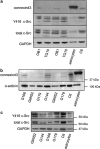
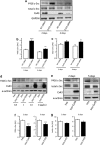
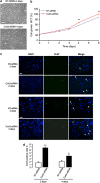
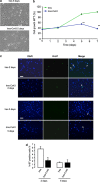
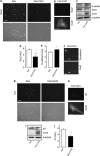
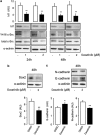


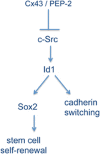
Similar articles
-
Connexin43 recruits PTEN and Csk to inhibit c-Src activity in glioma cells and astrocytes.Oncotarget. 2016 Aug 2;7(31):49819-49833. doi: 10.18632/oncotarget.10454. Oncotarget. 2016. PMID: 27391443 Free PMC article.
-
A Short Region of Connexin43 Reduces Human Glioma Stem Cell Migration, Invasion, and Survival through Src, PTEN, and FAK.Stem Cell Reports. 2017 Aug 8;9(2):451-463. doi: 10.1016/j.stemcr.2017.06.007. Epub 2017 Jul 14. Stem Cell Reports. 2017. PMID: 28712848 Free PMC article.
-
Dual inhibition of Src and PLK1 regulate stemness and induce apoptosis through Notch1-SOX2 signaling in EGFRvIII positive glioma stem cells (GSCs).Exp Cell Res. 2020 Nov 1;396(1):112261. doi: 10.1016/j.yexcr.2020.112261. Epub 2020 Sep 5. Exp Cell Res. 2020. PMID: 32896567
-
The role of connexin43-Src interaction in astrocytomas: A molecular puzzle.Neuroscience. 2016 May 26;323:183-94. doi: 10.1016/j.neuroscience.2015.02.029. Epub 2015 Feb 21. Neuroscience. 2016. PMID: 25711938 Review.
-
Opposing roles of connexin43 in glioma progression.Biochim Biophys Acta. 2012 Aug;1818(8):2058-67. doi: 10.1016/j.bbamem.2011.10.022. Epub 2011 Oct 29. Biochim Biophys Acta. 2012. PMID: 22063721 Review.
Cited by
-
Role of c-Src in Carcinogenesis and Drug Resistance.Cancers (Basel). 2023 Dec 20;16(1):32. doi: 10.3390/cancers16010032. Cancers (Basel). 2023. PMID: 38201459 Free PMC article. Review.
-
Targeting MAPK phosphorylation of Connexin43 provides neuroprotection in stroke.J Exp Med. 2019 Apr 1;216(4):916-935. doi: 10.1084/jem.20171452. Epub 2019 Mar 14. J Exp Med. 2019. PMID: 30872361 Free PMC article.
-
The SH3-binding domain of Cx43 participates in loop/tail interactions critical for Cx43-hemichannel activity.Cell Mol Life Sci. 2018 Jun;75(11):2059-2073. doi: 10.1007/s00018-017-2722-7. Epub 2017 Dec 7. Cell Mol Life Sci. 2018. PMID: 29218600 Free PMC article.
-
Connexin43 Suppresses Lung Cancer Stem Cells.Cancers (Basel). 2019 Feb 2;11(2):175. doi: 10.3390/cancers11020175. Cancers (Basel). 2019. PMID: 30717421 Free PMC article.
-
Mechanism of action of the anti-inflammatory connexin43 mimetic peptide JM2.Am J Physiol Cell Physiol. 2017 Sep 1;313(3):C314-C326. doi: 10.1152/ajpcell.00229.2016. Epub 2017 Jul 12. Am J Physiol Cell Physiol. 2017. PMID: 28701358 Free PMC article.
References
-
- Giaume C, Koulakoff A, Roux L, Holcman D, Rouach N. Astroglial networks: a step further in neuroglial and gliovascular interactions. Nat Rev Neurosci. 2010;11:87–99. - PubMed
-
- Rouach N, Koulakoff A, Abudara V, Willecke K, Giaume C. Astroglial metabolic networks sustain hippocampal synaptic transmission. Science. 2008;322:1551–1555. - PubMed
-
- Loewenstein WR, Kanno Y. Intercellular communication and the control of tissue growth: lack of communication between cancer cells. Nature. 1966;209:1248–1249. - PubMed
-
- Naus CC, Laird DW. Implications and challenges of connexin connections to cancer. Nat Rev Cancer. 2010;10:435–441. - PubMed
Publication types
MeSH terms
Substances
LinkOut - more resources
Full Text Sources
Other Literature Sources
Medical
Research Materials
Miscellaneous

